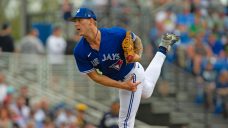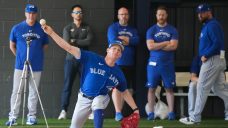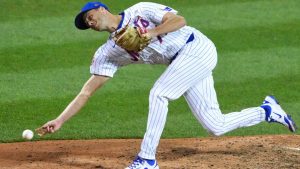DUNEDIN, Fla. — Over the course of his dozen-season MLB career, Brandon Belt’s had every reason to believe the baseball world was conspiring against him.
For starters, he entered the league playing home games at San Francisco’s Oracle Park, where stiff breezes blew in off McCovey Cove over a right-centre field alley that stretched 421-feet from home plate, ending at the base of a 20-foot wall. Oracle has played below-average for all hitters since Belt debuted in 2011, but for hitters like him in particular — pull-heavy, left-handed, extreme flyball hitters — it’s been kryptonite. You couldn’t have placed him in a less ideal environment anywhere this side of Oakland.
Let’s go ahead and chart the 103 times over his career that Belt’s hit a ball at least 375-feet in the air and not come away with a home run, then overlay them at another park — oh, let’s just pick one at random like, say, Toronto’s Rogers Centre:

That’s a few dozen more homers Belt could’ve had on his FanGraphs page over the years. And who knows how many more points of OPS. Or how many more zeros on his paycheque. It’s not like he merely settled for doubles or triples instead. More than half those balls resulted in outs.
“It was problematic for me as a young player hitting some balls that you know would go out pretty much anywhere else,” Belt says. “And not only were you not getting those homers — you weren’t even reaching base.”
Then, only a few seasons into Belt’s career, teams began understanding the power of the shift. By 2016, he was being shifted in over half his plate appearances — a number that only increased through 2022, when Belt was shifted over 85 per cent of the time. He’d always tailored his swing to elevate balls in play and stay off the ground. But that positioning meant the pitches Belt inevitably mishit became near-automatic outs.
Since 2016, Belt has a .201 wOBA on groundballs, nearly 50 points below the .246 xwOBA his quality of contact suggests he deserved. The league-average wOBA on groundballs over that span is .223. Of the 255 players to hit at least 500 groundballs since 2016, only 10 have a larger negative gap between their wOBA and xwOBA than Belt:

“You know going in that groundballs are typically outs in the big-leagues,” Belt says. “But when the shift started coming around a lot more, I simply couldn’t hit the ball on the ground. I’m screwed if I do.”
So, what did Belt do? He honed in on his approach. He hunted pitches middle-up. He designed his swing to create line drive contact that would lift balls further down in the zone — which, naturally, he’s seen progressively more of over the course of his career — beyond the infield wall teams built to his right. He worked on his bunting and began utilizing the tactic against teams that shifted him uber-aggressively or deployed four-outfielder alignments. He’s run the lowest groundball rate — 28.9 per cent — among 498 qualified MLB hitters since 2014.
And he vowed to never get himself out. Belt developed one of the game’s keenest understandings of the strike zone, posting chase rates within the top-20 per cent of MLB hitters each season since 2016. If he wasn’t being thrown pitches on the plate, he was determined to not offer and take his walks instead.
Only one problem. That approach’s success is dependent on another individual’s ability to judge balls from strikes — the umpire’s. And those individuals weren’t always as good at making those determinations as Belt was.
Since 2016, no player has struck out looking on pitches outside the strike zone — per StatCast’s interpretation — more often than Belt. And it’s not particularly close:
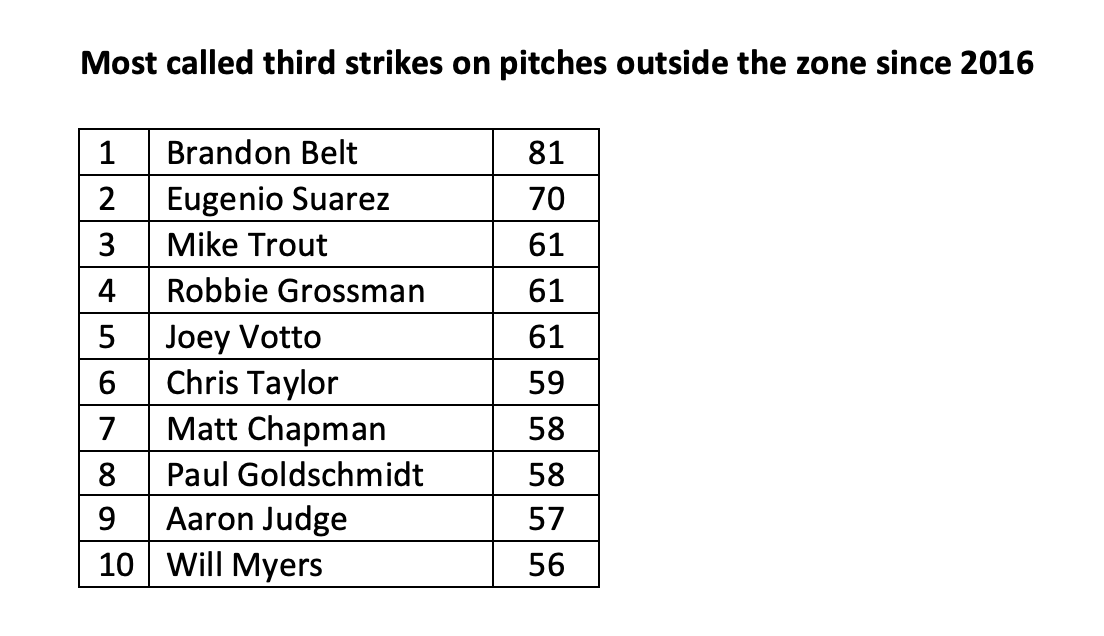
“Yeah, I’ve noticed that over the years,” Belt says. “That’s part of the game, unfortunately. I wish we could all be perfect out there. But we’re not.”
So, put yourself in his cleats for a moment. You’re playing in a ballpark seemingly designed to contain the style of contact you make, against opponents continually pitching you in the hardest areas of the zone to make that contact, while looking out at defenders positioned exactly where you most often send that contact, and standing before officials who keep saying you should’ve chased pitches you can’t even make contact against.
It's a minor miracle Belt’s even reached this point, with over 1,300 MLB games on his FanGraphs page, and a career .261/.356/.458 line beneath them. He’s hit 175 homers, put up a 124 wRC+, and lifted two World Series trophies over his head since he entered the league. And, if not for chronic cartilage issues in his right knee that have sabotaged several seasons of his career, he might have done even more. As if there weren’t enough variables conspiring against him.
“It’s been tough pretty much my whole career, figuring out the mentality I needed to have to be successful out there,” Belt says. “But I think I eventually got to the point of, ‘Hey, this is what I have to deal with. So, just go deal with it.’ When things are working against you, you can't let that affect you. You've just got to keep going. If you let it affect you, it can take you down a road it's hard to get off of.”
That road leads to a slump. Every hitter’s been there. No one’s immune to it. But what Belt’s learned over the years is that the way out of a slump isn’t to try harder. It isn’t to change anything. It’s to trust your approach and keep it consistent — no matter what’s happening outside your control.
“Absolutely. And I didn’t always do that. It's one of those things that I've had to learn,” Belt says. “But I‘ve seen over time how focusing on that stuff can really affect your play. If you think about it too much, you're not thinking about hitting the baseball. So, I've got to just let it go and move on. You have to just accept that stuff is going to happen sometimes.”
Sometimes, in the seventh inning of a tied ballgame, you’re going to execute an incredible swing on a changeup down in the zone — one of those pitches designed to induce groundball contact off Belt’s bat — and absolutely demolish a ball 407-feet at 107-m.p.h., only to watch it tracked down on the warning track:
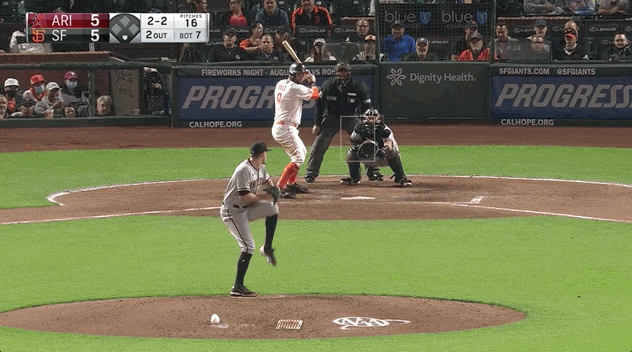
Sometimes, you’re going to smoke another one of those tough, diving pitches at the bottom of the zone at 108-m.p.h. off your bat and directly towards a third baseman playing in shallow right field:
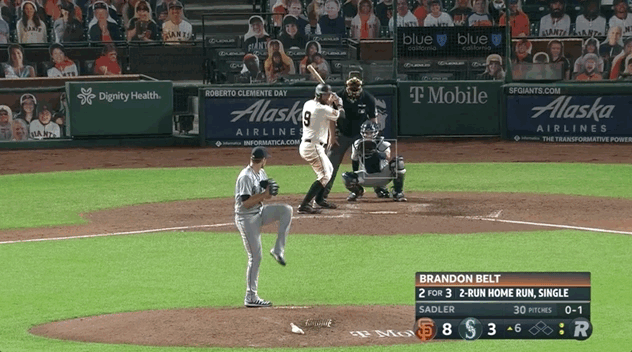
Sometimes, with the bases loaded in the ninth inning, you’re going to get rung up on a pitch above your chest to end a ballgame:
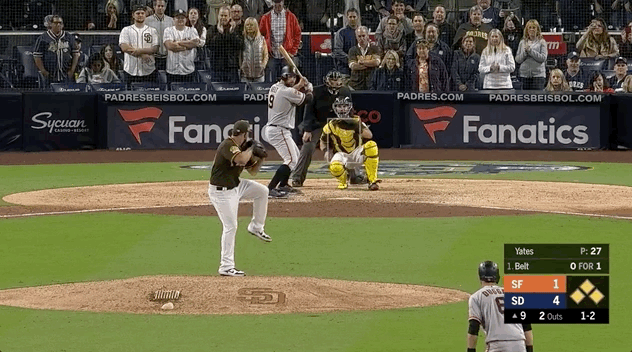
Sometimes, it’s going to feel like the entire baseball world’s conspiring against you. Doesn’t matter. Never. Change. The. Approach.
“You've got to trust yourself. I think that's what's helped me get better through a lot of challenges over my career,” Belt says. “I have to trust my hands. I have to trust my eyes. That's really tough to do — but it's something I work on in the cage.
“No matter what I'm doing, I’m working on that. If I'm practising my hitting, that's something I'm working on. If I’m taking groundballs at first base, it’s something I’m working on. I'm always working on my approach. It's not just always about going in there and being mechanical. It's about working on the mental stuff that you need to be successful in the game.”
That’s one thing the Blue Jays have learned about Belt throughout his first spring training with the club — he’s working smarter, not harder. He’s not the guy who will be dragging a fistful of bats out to the cages at the crack of dawn, asking a bleary-eyed coach to fire up the high-velocity pitching machine. You won’t hear his bat cracking away at pitch after pitch in the tunnel before a game. He’s not chasing quantity; he’s after quality.
Some days, Belt will only need a dozen or so pre-game cuts to determine his swing is prepared for competition. Once he’s in a good rhythm, seeing the ball well, and firing on time, he’s done all he needs. He knows the fleeting hours of his day are better spent loosening up physically, learning the tendencies of that night’s starting pitcher, or even just taking some solitary time to clear his mind.
“He knows himself really well,” says Blue Jays hitting coach Guillermo Martinez. “Knows his swing, knows what he needs to do to get it ready. He’s not going to be the guy taking a thousand cuts in the cage. He’s going to get right, feel right, and just walk away and take that into the game.”
To that end, Martinez’s conversations with Belt this spring have revolved around anything but hitting mechanics. It’s been mentality, approach, headspace. And the coach has done much more listening than talking.
Belt’s not particularly worried about how tight he’s keeping his elbows to his torso or how high he’s holding his hands. His swing’s his swing. He’s more concerned with adjusting his approach to how he’s being pitched. Always having a plan. Understanding the pitches he should be offering at and the one’s he shouldn’t.
“He doesn't ever want to get himself out. If he's going to get out, the pitcher gets him out. Not vice versa,” Martinez says. “It’s cool hearing him talk about his thought process behind that stuff. He just wants to swing at strikes. Especially these days where, in the game, there's a lot of balls being thrown.”
And that’s only one way the game itself may finally, at long last, be bending in Belt’s favour. He’s feeling as healthy as he has in years after off-season surgery to clean up the frayed cartilage that had been catching on his right kneecap. The hyper-aggressive shifts he so often faced are now regulated, with two infielders needing to be positioned on either side of second base, and all four required to be on infield dirt.
For the first time in his career, he’ll play home games in a favourable offensive environment, with Rogers Centre’s right-centre field power alley running only 359-feet from home plate with a 14-foot, 4-inch wall. That’s 62-feet closer than Oracle, with a half-foot less wall to clear. Belt’s hit 17 balls 359-feet or further since 2019 — the most of any Blue Jays hitter:

The only thing not turning Belt’s way is how balls and strikes are ruled. It’ll be a year or two yet before the ABS challenge system — in which teams can appeal to Hawk-Eye technology to confirm umpire calls they deem incorrect — makes its way to MLB.
But he’ll no doubt take the rest of it. And if that means Belt can do what he believes he can and recapture his 2020 and 2021 form, when Belt hit .285/.393/.595 with a 162 wRC+ across 560 plate appearances while playing through knee issues, the Blue Jays will take it, too.
“Hitting's really hard,” Belt says. “And I think the more you think about it, the tougher it gets. If you've got other stuff going through your mind while you're up at the plate, you're screwed. So, I literally try to make it as simple as possible. In my mind, I want to swing at strikes and not swing at balls. And from that point on, I just have to trust myself.”

